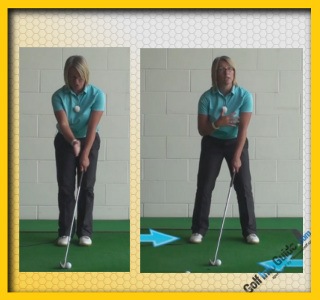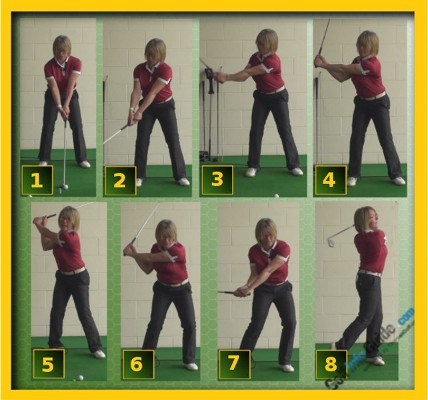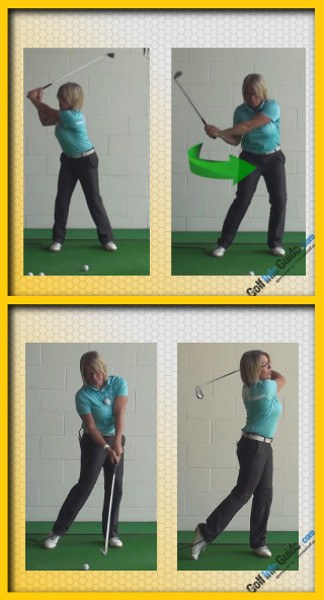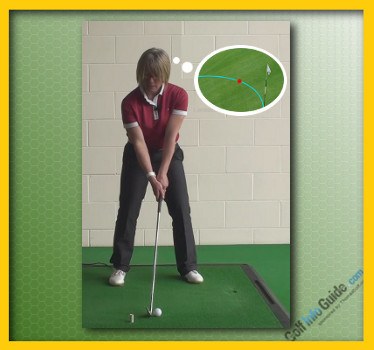
If we look at today's leading players in the world there are six golf swing basics that they all have.
Initially, they all hold the club correctly. Correctly held (for right handed golfers), the club should be held in the last three fingers of the left hand and the middle two fingers of the right hand with your left index finger and right little finger overlapping each other or interlocking. Either of these are fine but the hands link together to help them work as a unit rather than separate individual hands. If you take a coin and place it between either of your left or right thumb and hand, you should be able to hold that coin so that your thumb is directly next to your hand and you should also see that the coin points up towards your right shoulder. This will ensure that your hands and palm positions are on the club correctly, allowing you directional control over your golf shots. Double check the pressure that you are holding your club at. If 10 is maximum squeeze, gently hold at a 5 - hold rather than squeeze.
The next element that we see better players displaying in their golf swing is that they focus on their set up. They all use an effective repetitive pre-shot routine for this that allows them to get a feel for the shot they are about to hit and then lets them focus on the target to get correctly aligned. To do this well, stand directly behind the ball and target and pick a spot four inches in front of the ball on the target line. Now place the club head next to the ball so that the face is aligned to allow the ball to fly directly over your alignment spot. Once happy with the club face position, place your feet together, in line and parallel to the grooves on the club face. Now take a shoulder width stance from this position and you will be aligned correctly.

During the backswing, we see all of the world's leading players make a fantastic shoulder rotation to generate the most power from their swing. As they swing backwards, we see very little movement in their lower body but a huge 90 degree rotation to the right (for right handed players) in their upper body. This creates a huge amount of twist within their torso, or coil, which they can then unleash during their downswing to create great distance.
The most crucial part of any golf swing though is the position of impact, the club head into the ball. All of the top players demonstrate a 'power line' down their left side at impact. They have their weight 70% on their left foot with their right heel off the floor and their right foot starting to rotate towards the target. They have their hips rotated towards the target as much as possible but the chest is parallel to the target line. Their left arm is completely straight and their hands are in front of their left thigh so that they create a straight line from their left shoulder down to the left hand and then down to the club head just as or after they strike the ball.
On the finish of the swing, we see all great players displaying fantastic balance with 90% of their weight on the left side, their hips and chest rotated left of the target and the club wrapped around the back of their neck.
All of these characteristics will allow you to create power, speed, distance and accuracy and help you play a much more consistent game of golf.

Six Golf Swing Basics That the Best Golfers Have
If you have the opportunity from time to time to watch some of the golf tournaments shown on television, you are probably familiar with the swings of some of the world's top players. For a serious golfer, it is a thrill to watch the best players in the game do what they do. Golf is incredibly hard, as you already know, but the players on TV make it look so easy. For the average golfer, even hitting just one shot as well as those that are seen on TV would be incredibly exciting.
Of course, while watching those tournaments on TV, you have probably noticed that each golf swing you see looks a little bit different. No two players in the world have exactly the same swing – a fact that includes both professionals and amateurs. One of the interesting parts of the game is just how many different ways there are to get the ball to the hole. You don't have to swing like anyone else in order to be successful. You are free to be yourself on the golf course, and you can swing the club however you decide is going to be beneficial to your game.
With that said, there are some fundamentals within the golf swing that should be respected if you want to achieve your best possible results. The vast majority of professional golfers pay attention to these basics, while adding their own personal style on top to create a finished product. Ideally, that will be the same pattern that you will follow – build your swing on solid golf fundamentals, while staying true to yourself to wind up with a swing that you can trust.
The content below is going to present you with six of the fundamental basics that guide the golf swing. If you can obey each of these six 'rules' in your swing, you are almost certainly going to be happy with the outcome. All of the tips below have been written with a right handed golfer in mind – if you happen to play left handed, please take a moment to reverse the directions as necessary.

#1 – Balance
This is the point that should always be at the top of a list such as this. Balance is the single most-important element in your golf swing. Without balance, you will have a hard time hitting the ball at all, and the shots you do hit will be disappointing. Everything else that you do within your swing should be secondary to the goal of keeping your balance. If you have to sacrifice a bit of balance in order to add something else to your swing, that 'something else' should be left out.
The importance of balance should be easy to see when you do take a moment to watch golf on TV. The top players in the world are almost always balanced from start to finish within their swings. It takes great precision to strike the ball cleanly at impact, and precision is something that is closely associated with balance. When you know where your center of gravity is going to be at all times during the swing, finding the bottom (and clean impact) becomes much easier.
If you are struggling with balance in your swing, the first place to look is your stance. You should have your feet shoulder width apart (approximately) and your knees slightly flexed at address. Missing on either of these points will make it tough to keep your balance all the way through the swing. Many amateur golfers stand over the ball with very little flex in the knees, and they wind up moving all over the place during the swing as a result.
Another mistake that can cost you from a balance perspective is simply swinging too hard. Everyone wants to hit the ball long distances – and that's great – but your level of effort in the swing should not reach a point where you can no longer stay balanced time after time. In fact, sheer effort doesn't even equate directly to distance in the first place. If you would like to hit the ball farther, you will focus on balance and correct mechanics, as that is where you are going to find those extra yards you desire.

#2 – Relaxed Grip Pressure
Unlike balance, this is a basic fundamental of the golf swing that isn't talked about very often. Unless you have taken some formal golf lessons at some point in the past, you might not even have been aware of the fact that grip pressure can play a big role in the kinds of shots you hit. Players at the top of the game all use a relaxed grip pressure while making a swing in order to allow the club to move freely through the hitting area. Unfortunately, many amateur golfers do the opposite, squeezing the handle of the grip tightly while restricting swing speed in the process.
Many golfers hold onto the club tightly because they don't want to lose control through impact. And, of course, this is a valid concern. You certainly don't want to send the club flying out of your hands when you make contact, so it is important that you use enough grip pressure to stay in control at all times. In the end, this is really your biggest challenges when it comes to the grip – finding an amount of pressure that will allow you to keep control over the club while still swinging it freely. It might take you some time to locate this 'happy medium', but your effort will be worth it when you see the improvements you can find in your swing.
To learn how to hit shots with a relaxed grip pressure, head over to the short game practice area at your local course. While hitting some chip and pitch shots, work on using a light grip throughout your swing. Since you are hitting short shots, there won't be as much concern over having the club slip out of your hands. Once you start to get comfortable with the idea of using a light grip, you can gradually hit longer and longer shots until you reach your full swing. It will take plenty of practice in order to build up enough trust to use a lighter grip on the course, so don't make the mistake of rushing out to the first tee after just a few practice shots. Take your time in learning this fundamental, and only go back to the course for a round when you are sure that you are ready.
The last point that needs to be made relating to grip pressure has to do with the condition of your grips and your golf glove (if you use one). There needs to be a nice connection between your hands and the club at address, and that starts with using grips that are in good condition. Keep your grips clean and replace them periodically – otherwise, you may be trying to make good swings with grips that are too slick for the job.

#3 – Back to the Target
As you get started in your backswing, you should have just one basic goal for your backswing – to turn your back to the target by the time you reach the top of the swing. This sounds like a simple point, and that's because it is. However, this is also a very important point, and it is the one that should dominate your thinking during the first phase of the swing. If you can just get your back to face the target at the top – which maintaining your balance, of course – you will be set up for an excellent downswing. Most amateur golfers never do reach the point of getting their back turned to the target at the top, and they lack power and accuracy as a result.
For golfers who are relatively flexible in their core, turning all the way back isn't going to be much of a problem. However, golfers who are a little stiffer through their lower back and abdominals might find this to be a bit of a challenge. If you find that you are having trouble getting all the way back, there are a couple of adjustments you can make in order to facilitate a great turn. Those adjustments are as follows –
- Turn your right foot out. Simply turning your right foot a little bit to the right will make it easier to rotate your upper body away from the target. Your right leg will not be providing as much resistance to the turn when you place your foot in this way, so you will be free to rotate back without a lot of pressure on your right knee. As such, this is also a good tip for players who have knee problems when they golf.
- Added knee flex at address. Another way to make the turn a little easier is to add flex in your knees when you address the ball. This adjustment will make you more athletic over the shot, and it should enable your hips to move a little more in order to help your back get to where it needs to be. There are a number of benefits to having plenty of knee flex in your address position, and this is just another one to add to the list.
In addition to helping you build speed on the way down, making a full turn is also beneficial in that it will promote an even tempo throughout the swing. Those who cut the backswing short tend to rush their overall tempo, which is always a bad thing from a ball striking perspective. During your next practice session, work on making a full turn away from the target and you should see your ball striking improve almost immediately.
#4 – Hands Win the Race
During every swing, there is a race taking place between your hands and the club head. That race is contested from the top of the swing down to impact, and it is imperative that the hands win the race each and every time. Many amateur golfers allow the club head to win that race during the majority of their swings, and the results are damaging. If you would like to hit powerful shots that head toward their intended targets more often than not, ensuring your hands win the race down is one of the most-important things you can do.
At this point, you might be a bit confused – aren't the hands and the club head attached to the same club? How could one with a 'race' with the other? Well, yes, they are attached to the same club, but one of them is going to arrive at the bottom of the swing first. In a good golf swing, the club head will lag behind the hands during the downswing, and the hands will arrive over top of the ball while the club head is still a couple of feet away from impact. When this happens, the club head will 'whip' through the hitting area, closing down those last couple of feet in just a fraction of a second. This is now power is created in golf. If you have ever wondered how professional golfers are able to hit the ball so hard without swinging out of their shoes, this is the answer – they lag the club beautifully and allow it to accelerate like crazy at the bottom.
If you struggle to hit your shots a distance that you would consider to be acceptable, there is a good chance that you are currently losing this race with your hands. Most likely, the club head is getting a head start right from the top of the swing thanks to your hands releasing the angle and pushing the club head down toward the ball. Once you make that move at the top, there will be no hope of catching up later. Your hands are going to remain behind in this race if they start behind, meaning you will just drag the club through the ball. There will be no lag to release aggressively, and your club head speed will be disappointing.
To fix this problem and give your hands the victory they need, do your best to pull the hands down toward the ball right from the top of the backswing. As soon as your backswing finishes, you should be using your body to turn toward the target while you pull the butt end of the club down toward the ball with the back of your left hand. At the same time, your right hand should stay out of it and you should allow the club head to take its time. As long as you start off correctly in the transition, the rest of the downswing should be fine, and your hands should win the race.
#5 – No Holding Back
The outcome of your swing is pretty much decided by the time you get halfway down into the downswing. You have done the hard work of making a good backswing and a proper transition, and now it is time to simply enjoy the payoff for that work. Assuming you laid the groundwork correctly, all you have to do now is swing through the shot and look up to watch the ball sail toward the target.
Of course, many golfers aren't willing to leave well enough alone. In fear of hitting a bad shot, many players will ease up on their swing right at the moment when they need to trust it the most. During the downswing, there can be no hint of let up and deceleration in the swing. Commit to your swing, trust the mechanics you have used up to that point, and swing through the ball with confidence. You aren't always going to hit good shots, but you need to believe in yourself enough to give each swing the best possible chance at success.
The best way to conquer this point is to have the right mindset for the swing. After you have completed the transition, your mind should switch over to having just one goal – swinging all the way up to the finished position. If you can arrive at a full finish after your swing, you will know that you have maintained your club head speed and moved through the shot with confidence. When you see someone hitting a full shot that doesn't end in a full finish, you can be sure that they lacked the confidence to finish the job.
When you are finished with your full swing, you should be balanced nicely on your left foot with your chest facing out toward the target. This is the classic golf 'pose', and you certainly see it time and time again if you watch golf on TV. Make it a goal to hold that pose after each swing until the ball hits the ground. If you can stay up in that position all the way throughout the flight of the ball, you will know that you have kept your balance nicely and that you have swung through confidently to a full finish.

#6 – Leaving Mechanics Behind
When a good player walks from the driving range to the first tee, he or she tries to leave all mechanical swing thoughts behind. Golf is not a game that can be played well while there is a stream of mechanical or technical thoughts running through your head – instead, it is a game that should be played with feel and touch. The driving range is a great place to learn how to swing the club, and to engrain the proper mechanics into your muscle memory. However, once you leave the range and get your round started, you should do your best to focus your mind in on picking smart targets and making confident swings. It is too late when you are out on the course to get your mechanics whipped into shape, so you might as well do your best with the swing you have for now.
Many golfers have trouble taking their 'range swing' out to the course, and it is likely because they are unable to relax and just execute the swing that they have worked so hard to build. Golf is not a game that can be conquered with sheer effort – trying extra hard usually results in disappointing outcomes. Instead of overdoing it from an effort perspective, just relax and allow your talent and preparation to show through. After the round is over, you can look back at the shots you hit and decide how you need to improve for next time. It is this cycle of constant improvement – back and forth between the range and the course – that will lead you to become a better player in the end.
There is no group of players in the world better at leaving their mechanics behind on the range than the pros you see playing on TV. Playing professional golf is a highly-stressful, nerve-wracking way to make a living. In order to deal with that pressure and still create great shots, pro golfers have to understand how to compartmentalize everything going on in their heads. The driving range thoughts simply have to be left behind or they will destroy a player's performance during a tournament. While you might not have the same kinds of stakes on the line when you tee it up, it is still an important lesson to learn – your swing will perform far better if you just let it happen when you get out onto the course.
The basics above combine both physical and mental tips. All of these elements are important to building a good swing, and you should give all six of them the proper attention as you prepare for your upcoming rounds. One of the best things about golf is the opportunity to get better each time you play, but those improvements don't happen by accident. It is only the golfers who take the time to practice and think about their games that will wind up lowering their scores. Good luck!






